
This booklet that aims to bridge the knowledge gap by offering a Nepal-focused, comprehensive, and easy to understand guide on climate induced Loss and Damage (L&D) is the Nepali version. Targeted at a diverse group of stakeholders—including policymakers, vulnerable communities, local government representatives, non-governmental organizations, and leaders advancing the L&D agenda in Nepal—this guide presents scientific insights, relevant policies, financial implications, potential solutions, and international frameworks in a clear and organized format.

This booklet that aims to bridge the knowledge gap by offering a Nepal-focused, comprehensive, and easy to understand guide on climate induced Loss and Damage (L&D) is the English version. Targeted at a diverse group of stakeholders—including policymakers, vulnerable communities, local government representatives, non-governmental organizations, and leaders advancing the L&D agenda in Nepal—this guide presents scientific insights, relevant policies, financial implications, potential solutions, and international frameworks in a clear and organized format.

This factsheet is an infographic representation of the climate-relevant budget allocated by the federal and provincial governments of Nepal for the fiscal year 2024/25. It is part of the ongoing advocacy efforts by the Prakriti Resources Centre in promoting transparency and accountability in climate finance.
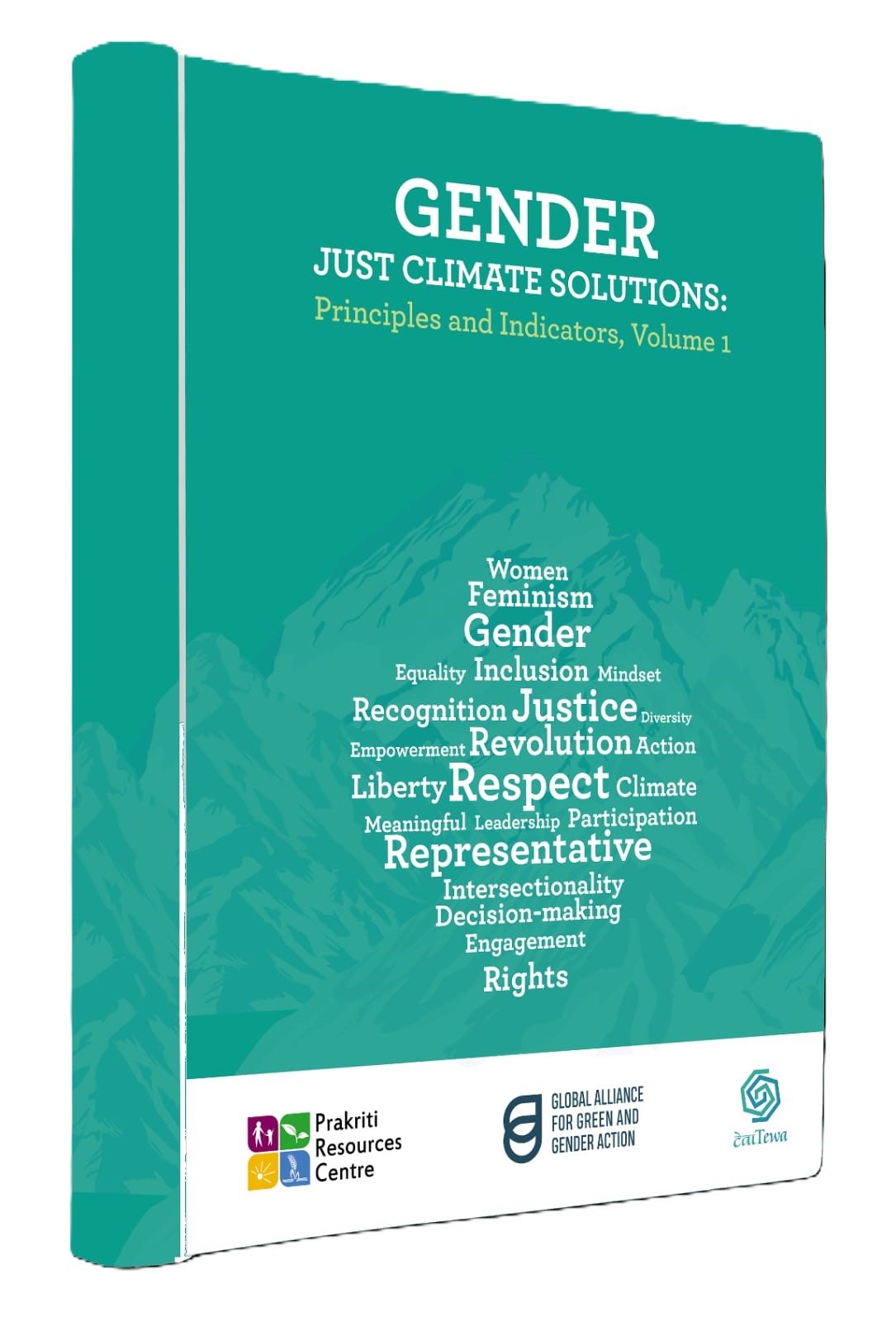
The paper ‘Gender- Just Climate Solutions: Principles and Indicators, Volume 1’, attempts to highlight the first four fundamental principles of gender-just climate solutions along with the qualitative and quantitative indicators for achieving gender justice in climate and development context. The findings of this paper is entirely Nepal based.
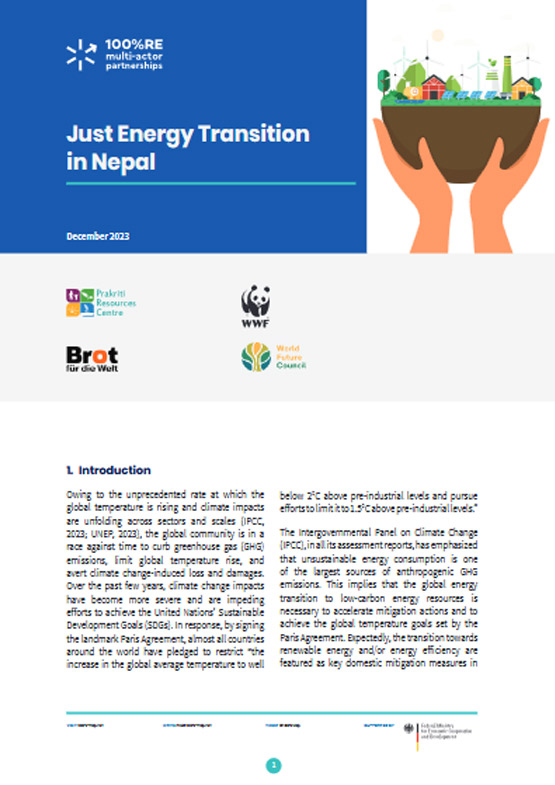
This paper provides brief information on Just Energy Transition (JET) in the context of Nepal focusing particularly on residential sector (with focus on clean cooking and electricity services) which is the largest energy-consuming sector and largest source of GHGs in the country. It recommends for energy transition to be just and sustainable, must be planned and implemented in the context of sustainable development, gender equality, social inclusion and poverty eradication, and be grounded in the development needs and aspirations of the societies within which they occur. It has developed under the MAP for 100% RE project.
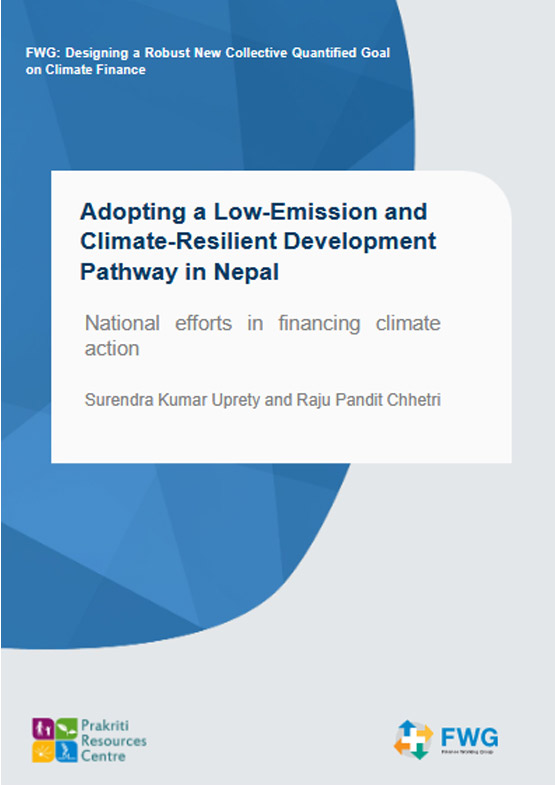
This report examines Nepal’s progress towards low-carbon and climate-resilient development pathways, asking what institutional barriers exist to financing climate action, how policy, government tools and legislative provisions have addressed climate change and the challenges and opportunities that arise when financing Nepal’s green and inclusive development goals. Focussing on both Article 9 and Article 2, paragraph 1(c) of the Paris Agreement, the paper provides an evaluation of Nepal’s progress towards its climate ambitions so far.
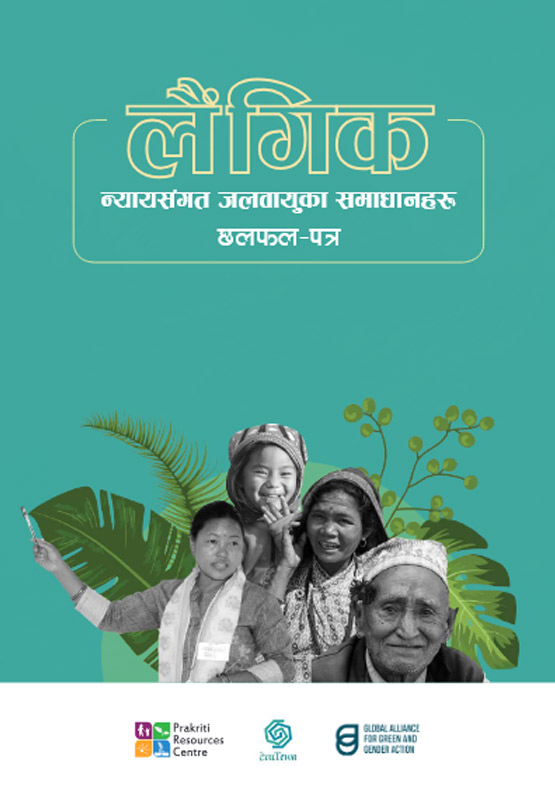
This paper focuses on climate actions being undertaken at the community level in Nepal. The findings of this paper is expected to be useful for government agencies, development partners, women and environmental organizations, academics, and other stakeholders to work in the intersection of women rights and gender justice, particularly in designing and implementing gender just climate solutions in their programs and projects. This paper also aims to build a common understanding of the term ‘gender-just climate solutions.’
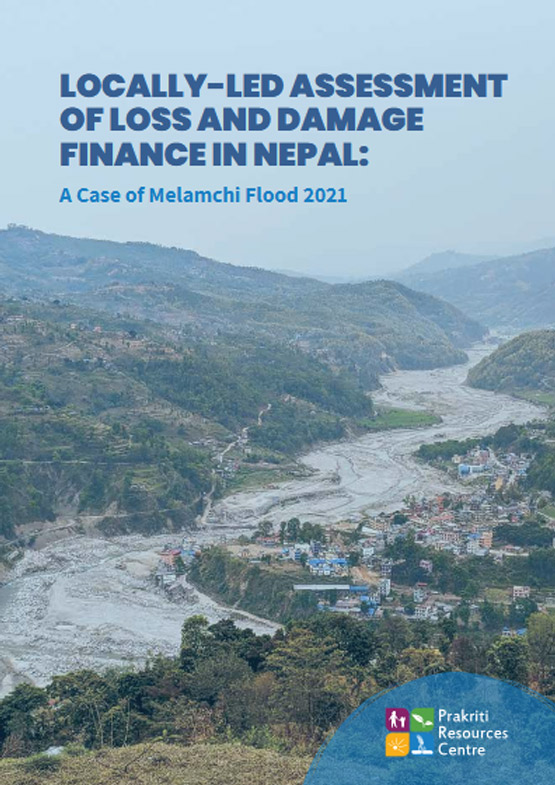
The report presents the findings of a study on loss and damage resulting from the Melamchi flood of June 15, 2021. It reveals an economic loss per household of USD52,113, but households received an average of only USD380, leaving a substantial gap of USD51,733. The total economic loss of USD498 million is estimated in Melamchi Municipality and Helambu Rural Municipality. Non-economic damages include loss of human well-being and health, aesthetics, cultural assets, and biodiversity. 85% of respondents are facing mental health problems, and 51% reported significant impacts on social interactions. The flood also had a significant effect on cultural and religious sites such as cremation sites, temples, and stupas.
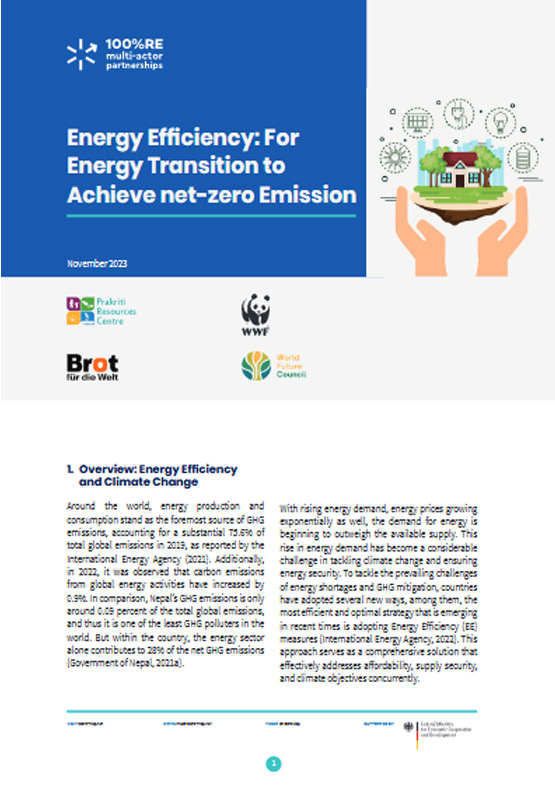
The paper “Energy Efficiency: For Energy Transition to Achieve Net-Zero Emission” developed under the MAP for 100% RE project inform on Nepal’s energy efficiency status, stressing its importance in achieving net-zero emission target and SDGs. It recommends for adoption of energy efficiency policies for improving energy access and energy security and meeting the climate commitments.
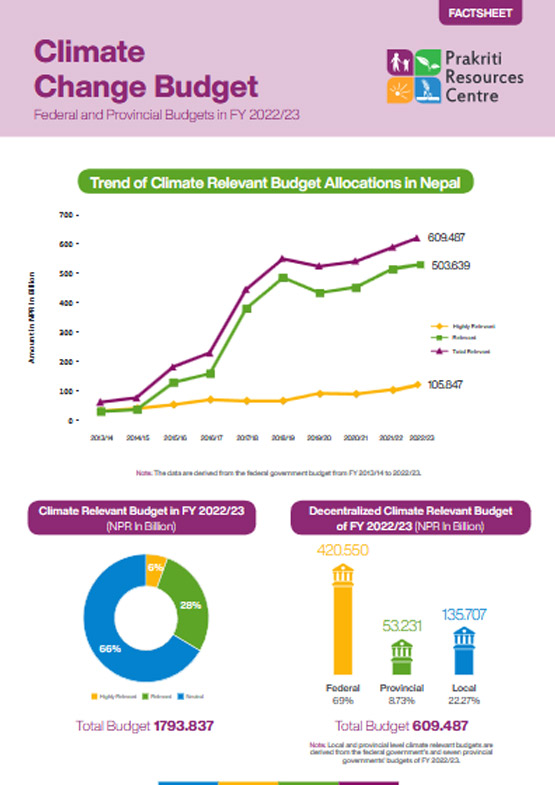
This fact sheet provides a graphical presentation of the climate-relevant budget of the federal and provincial governments of Nepal in FY 2023/24. This is part of the PRC’s ongoing advocacy to make climate finance transparent and accountable.
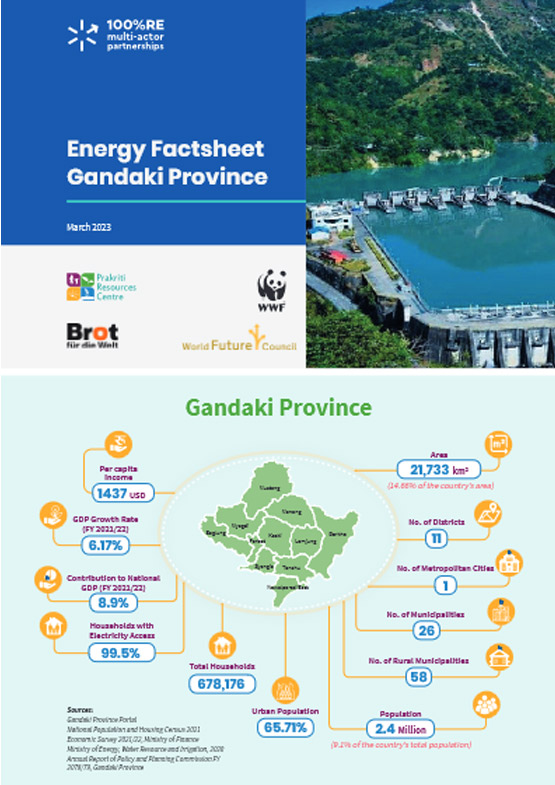
This factsheet provided brief information on the status of energy, energy generation (Hydropower, Solar, Wind), fossil fuel consumption, existing policies and institutional arrangement. This is published under the “Multi-Actor Partnerships (MAPs) for Implementing NDCs with 100% Renewable (RE) for all in the Global South”. This is made possible by the support of the Federal Ministry for Economic Cooperation and Development (BMZ), Germany.
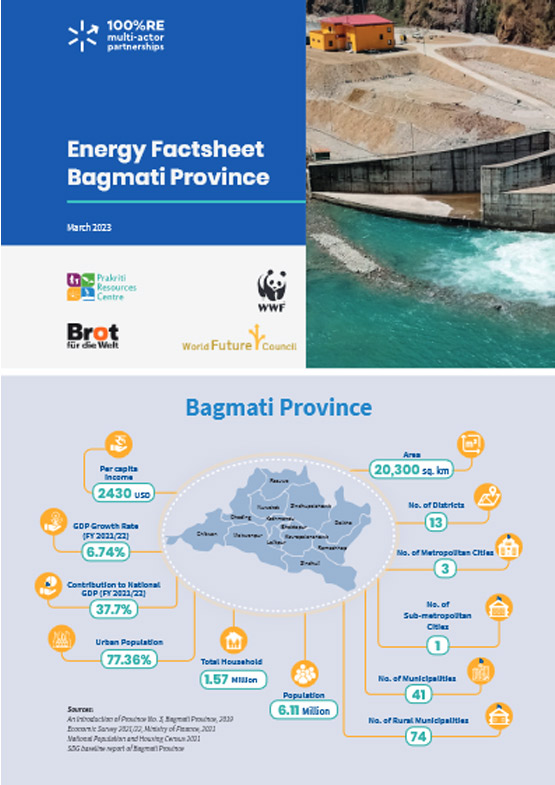
This factsheet provided brief information on the status of energy, energy generation (Hydropower, Solar, Wind), fossil fuel consumption, existing policies and institutional arrangement. This is published under the “Multi-Actor Partnerships (MAPs) for Implementing NDCs with 100% Renewable (RE) for all in the Global South”. This is made possible by the support of the Federal Ministry for Economic Cooperation and Development (BMZ), Germany.
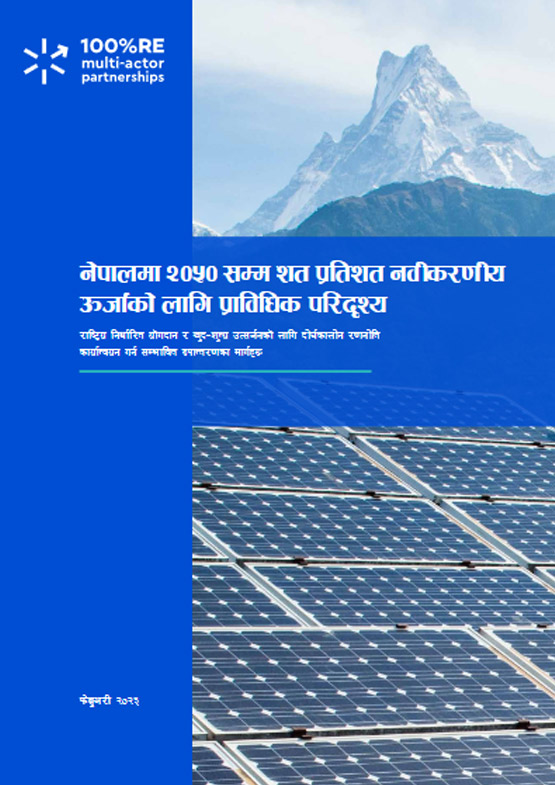
This is the Nepali version of the Executive summary of “Technical Scenario for 100% Renewable Energy in Nepal by 2050: Possible Transition Pathways for NDC & LTS Implementation” prepared by MAP for 100% RE project. The document was launched in the presence of government, non-government, academia, and other relevant stakeholders on April 10, 2023.
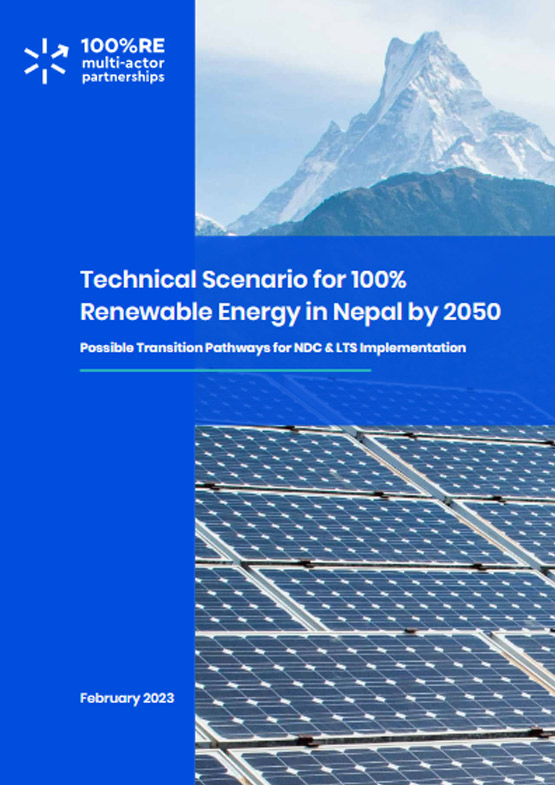
WWF Nepal and Prakriti Resources Centre (PRC), has prepared a “Technical Scenario for 100% Renewable Energy in Nepal by 2050: Possible Transition Pathways for NDC & LTS Implementation”. The document was launched in the presence of government, non-government, academia, and other relevant stakeholders on April 10, 2023.
This report has presented three scenarios- i. Reference scenario ii. with the existing measures iii. Nepal’s 1.5 °C scenario. It is expected to be a crucial tool for decision-makers, planners, government agencies, researchers, and advocates to promote a clean energy mix in the country.
Nationally Determined Contribution (NDC) is a national climate plan highlighting a country’s climate actions, including its climate-related targets, policies and measures, that it aims to implement in response to climate change and global climate action. This document track the progress made to achieve Nepal’s NDC targets in 2021.
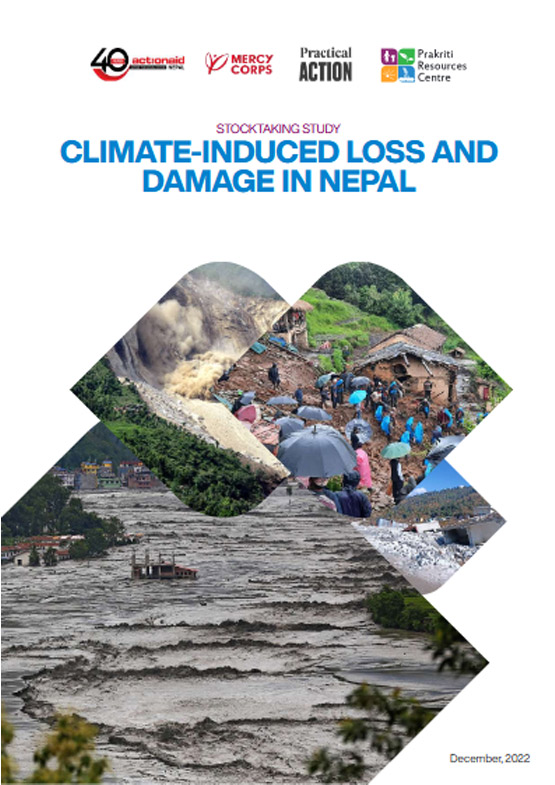
This paper’s objective is to stocktake existing knowledge on climate-induced loss and damage based on different studies related to recent climate-induced disasters in Nepal. This paper covers five climatic disasters that hit Nepal in the last 20 years, of which loss and damage reports were published. This paper includes both academic and non-academic papers. Non-climatic disasters and other climatic disasters that hit Nepal have not been included.
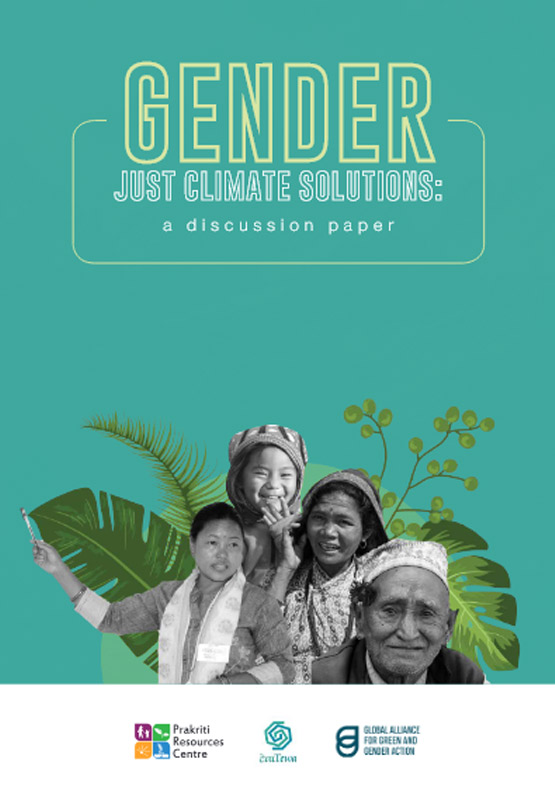
This paper focuses on climate actions being undertaken at the community level in Nepal. The findings of this paper is expected to be useful for government agencies, development partners, women and environmental organizations, academics, and other stakeholders to work in the intersection of women rights and gender justice, particularly in designing and implementing gender just climate solutions in their programs and projects. This paper also aims to build a common understanding of the term ‘gender just climate solutions.’
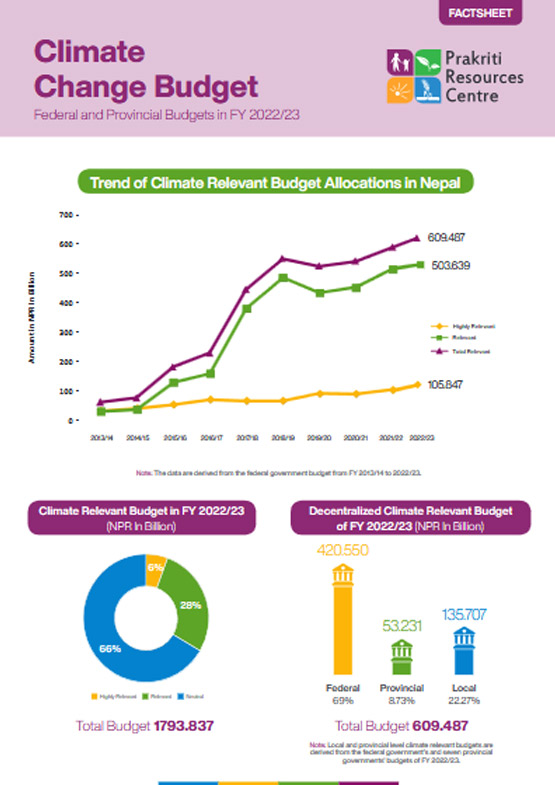
This fact sheet provides a graphical presentation of the climate-relevant budget of the federal and provincial governments of Nepal in FY 2022/23. This also shows a trend of climate change relevant budget by the federal government of Nepal since FY 2013/14. This is a part of PRC’s ongoing advocacy to make climate finance transparent and accountable.
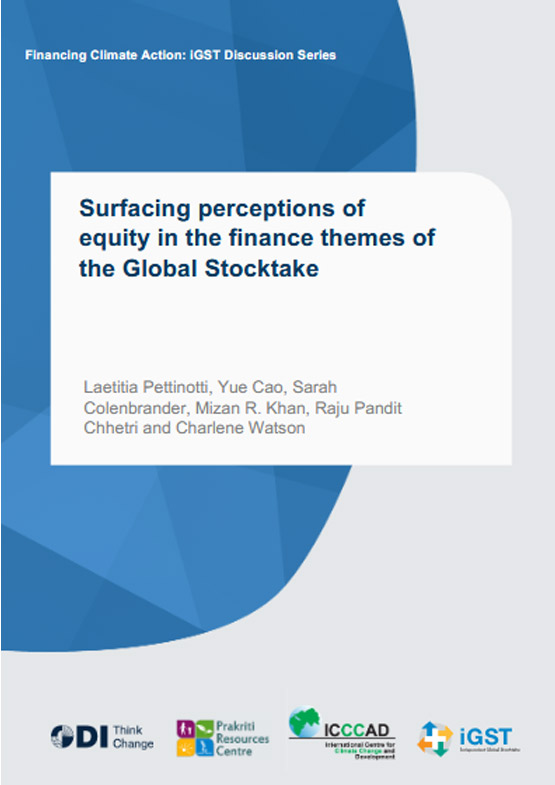
This paper explores perceptions of equity and fairness in financing climate action. This also examine whether developed countries are fulfilling their climate finance pledges, whether those pledges are ambitious enough and what more needs to be done in financing climate action to meet the temperature goals of the Paris Agreement. This analysis highlights, however, that as an exercise to understand collective progress, the GST will need to accommodate multiple viewpoints and even diverging worldviews when fulfilling its mandate to address equity in finance themes.
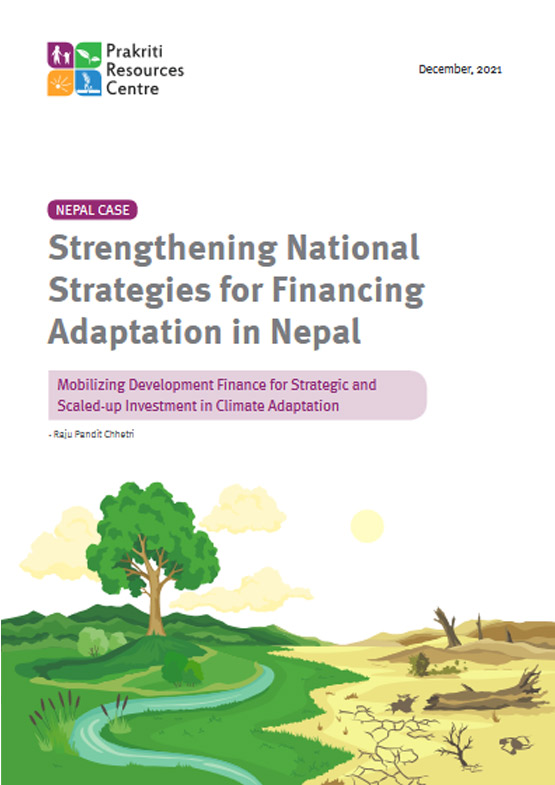
‘Strengthening National Strategies for Financing Adaptation in Nepal’ is a case study that explores Nepal’s perspectives and needs in regard to increasing the volume and quality of finance for adaptation, including financing from Multilateral Development Banks (MDBs) and initial efforts to lay the groundwork for a financing strategy for adaptation. This paper also looks into the challenges and opportunities and how to overcome the constraints. It is a part of the “Mobilizing Development Finance for Strategic and Scaled-up Investment in Climate Adaptation” research project.
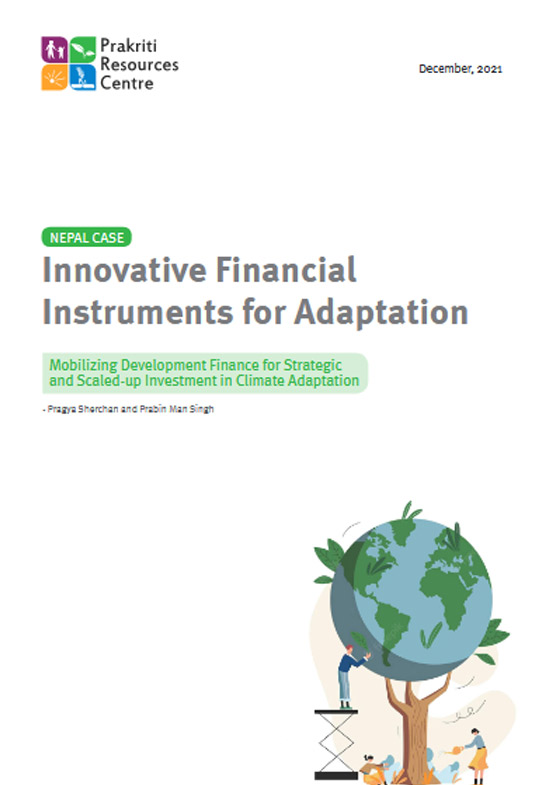
‘Innovative Financial Instruments for Adaptation’ is a case study that provides the learning on scaling up finance for adaptation that emerged through the public and private sector collaboration to enhance food security through promoting climate-resilient agriculture in Nepal. It also explores the challenges of scaling up finance for adaptation across different contexts and opportunities to overcome these constraints. It is a part of the “Mobilizing Development Finance for Strategic and Scaled-up Investment in Climate Adaptation” research project.
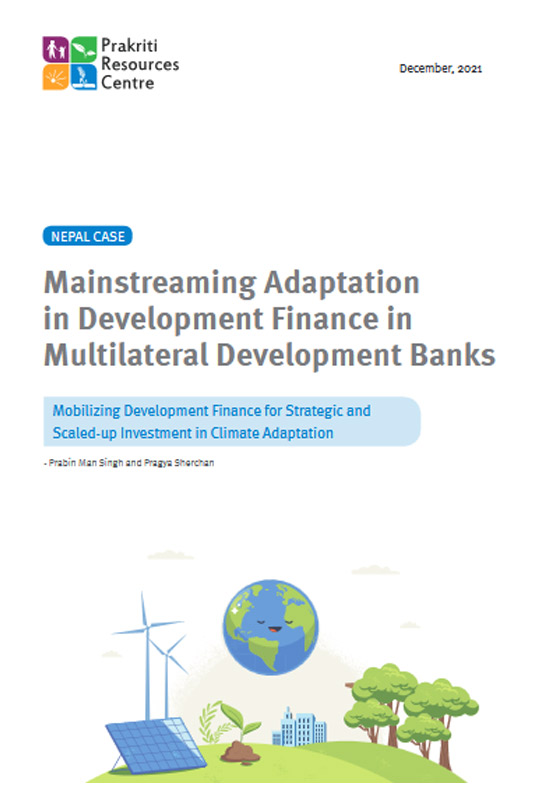
‘Mainstreaming Adaptation in Development Finance in Multilateral Development Banks’ is a case study that provides insights on how MDB finance has been mainstreamed into development finance to promote climate-resilient development in Nepal. The research explores challenges to scaling up finance for adaptation across different contexts and opportunities to overcome these constraints. It is a part of the “Mobilizing Development Finance for Strategic and Scaled-up Investment in Climate Adaptation” research project.
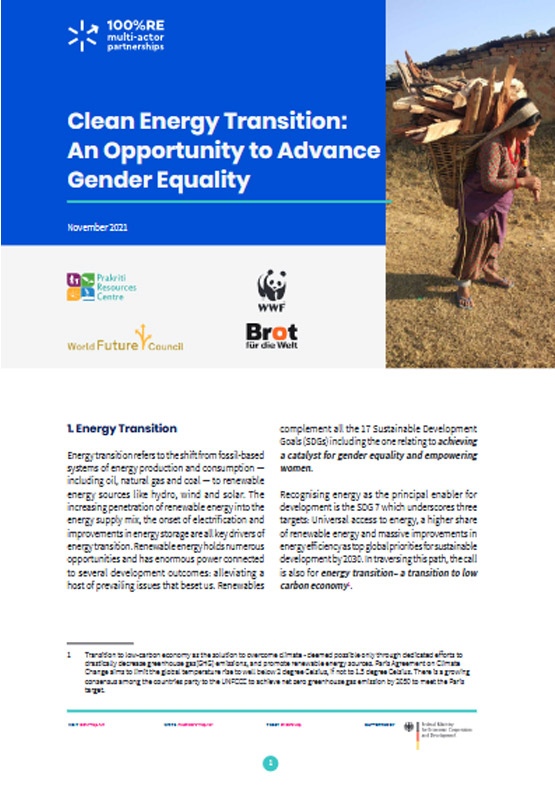
This paper is an attempt to provide an insight into the current status of gender and energy in Nepal based on the analysis of relevant policy documents and consultations with selected key stakeholders. This leads to a set of recommendations for ensuring gender considerations in the process of transitioning to clean energy systems, overcoming the barriers and for tapping the available opportunities.
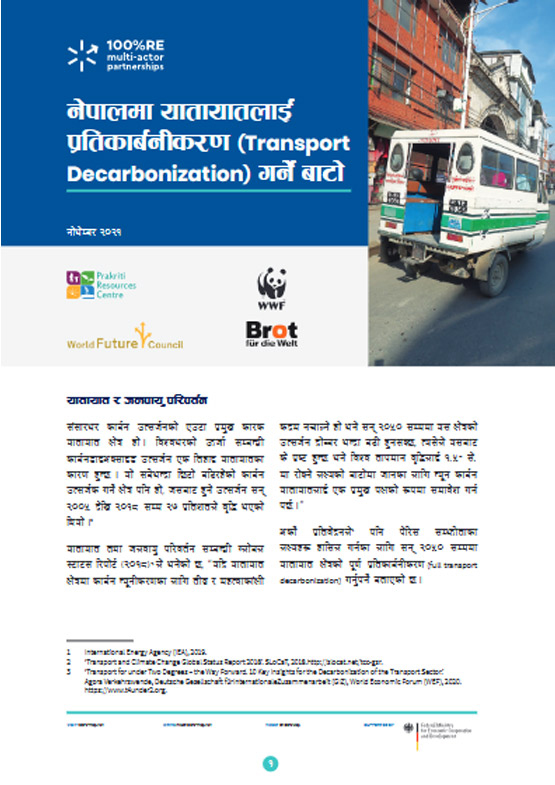
This paper is the Nepali version of Pathways to Transport Decarbonization in Nepal. transport accounts for nearly one-quarter of global energy-related carbon dioxide (CO2) emissions, the second-largest source after electricity and heat producers. It is also the fastest-growing source of carbon emissions, with its emission rising more than 27% from 2005 to 2018. This policy brief discussed climate change and transport, Nepal’s commitments, policies, and pathways on decarbonizing transport.
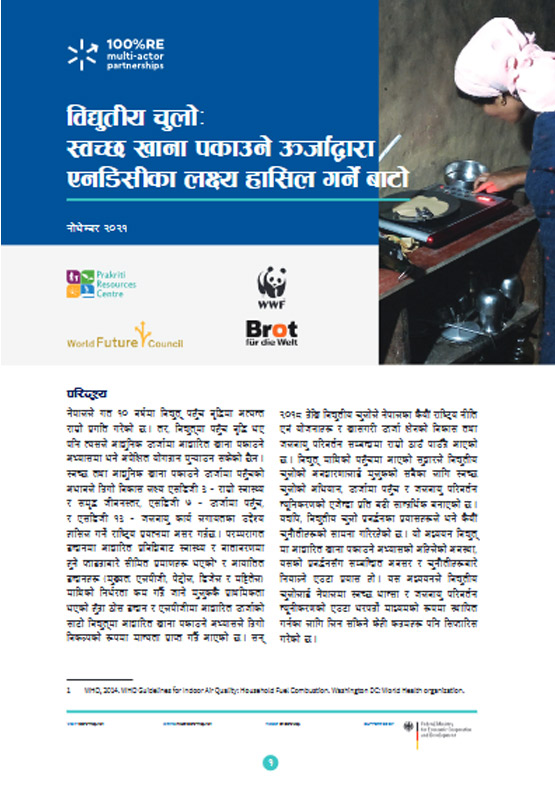
This is the Nepali version of Electric cooking solutions: The pathway to achieving Nepal’s NDC targets. This paper is an attempt to take a look at the current status of electric cooking, opportunities for its promotion, and challenges. It also recommends the way forward to establish electric cooking as viable clean cooking and climate change mitigation option for Nepal.
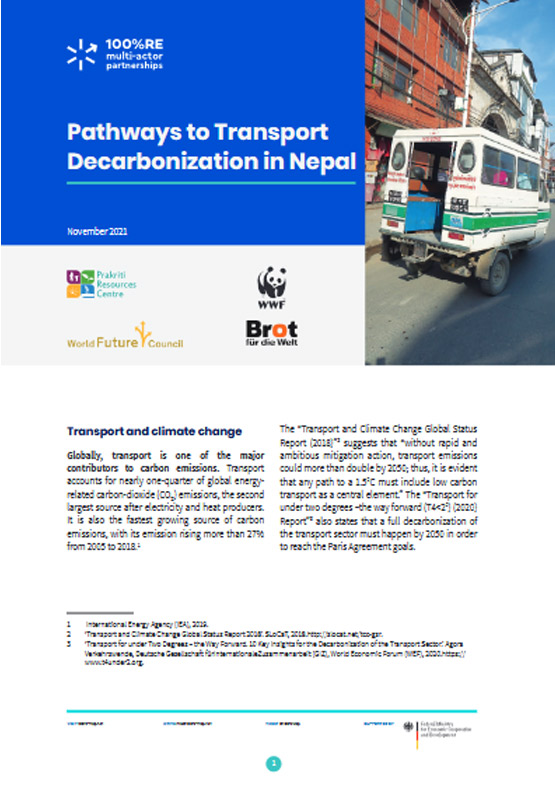
Transport accounts for nearly one-quarter of global energy-related carbon dioxide (CO2) emissions, the second-largest source after electricity and heat producers. It is also the fastest-growing source of carbon emissions, with its emission rising more than 27% from 2005 to 2018. This policy brief discussed climate change and transport, Nepal’s commitments, policies, and pathways on decarbonizing transport.
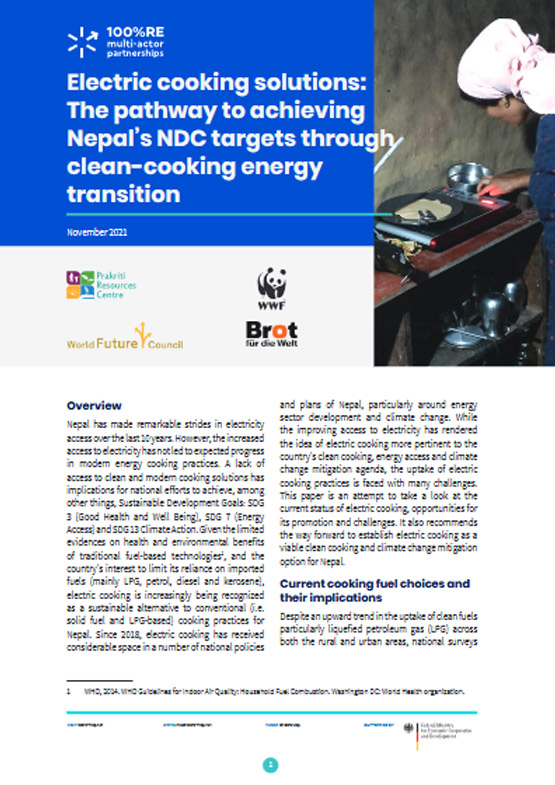
This paper is an attempt to take a look at the current status of electric cooking, opportunities for its promotion, and challenges. It also recommends the way forward to establish electric cooking as viable clean cooking and climate change mitigation option for Nepal.
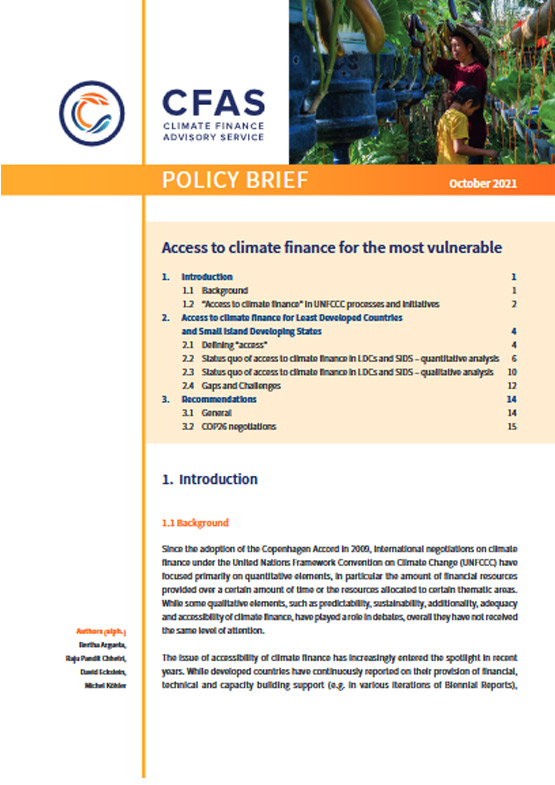
This policy brief aims to provide an in-depth analysis on the issue of accessibility of climate finance. The brief relies on publicly available literature and data, as well as input received from stakeholders during a dedicated thematic roundtable in which negotiators and representatives from National Designated Authorities (NDAs), implementing entities, NGOs, and academia from LDCs and SIDS shared their experiences and perspectives. Finds more on: https://www.cfas.info/en/publication/access-climate-finance-most-vulnerable
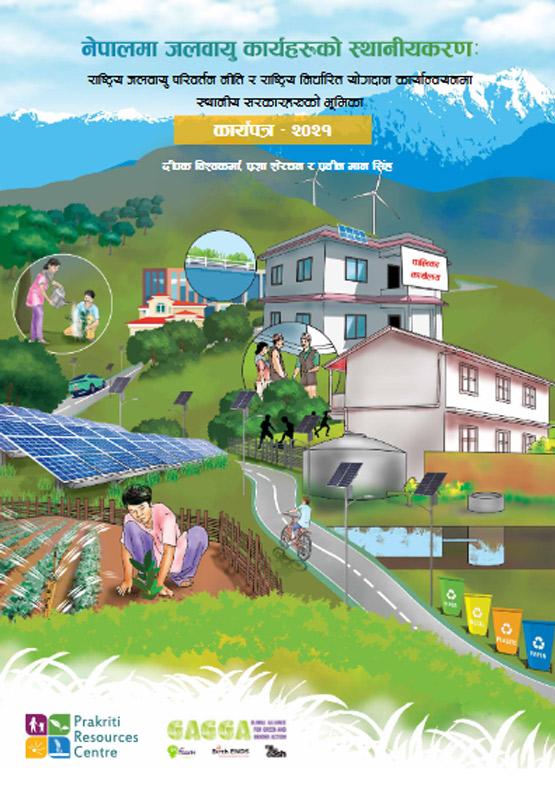
This working paper examines the role of local governments and analyses the barriers to and potential options of localizing the National Climate Change Policy (NCCP) and the second Nationally Determined Contributions (NDC) of Nepal. Lack of local governments’ familiarity with NCCP and second NDC, absence of qualified human resources, inadequate funding, non-existence of institutional mechanism to lead the implementation of policies, and monitoring of the implementation status were the identified barriers. It has proposed a four-pillar framework for effective localization of NCCP and second NDC. It is an output of the project funded by Both ENDS and GAGGA.
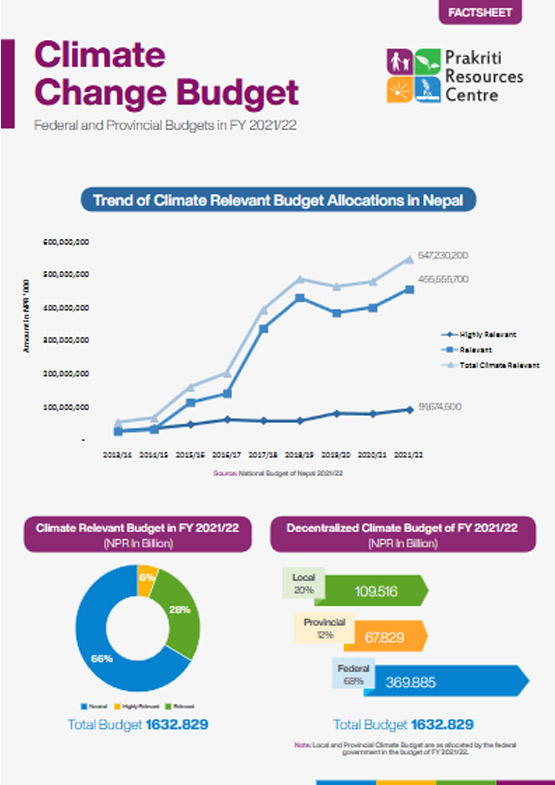
This fact sheet provides a graphical presentation of the climate-relevant budget of the federal and provincial governments of Nepal in FY 2021/22. This also shows a trend of climate change relevant budget by the federal government of Nepal since FY 2013/14. This is a part of PRC’s ongoing advocacy to make climate finance transparent and accountable.
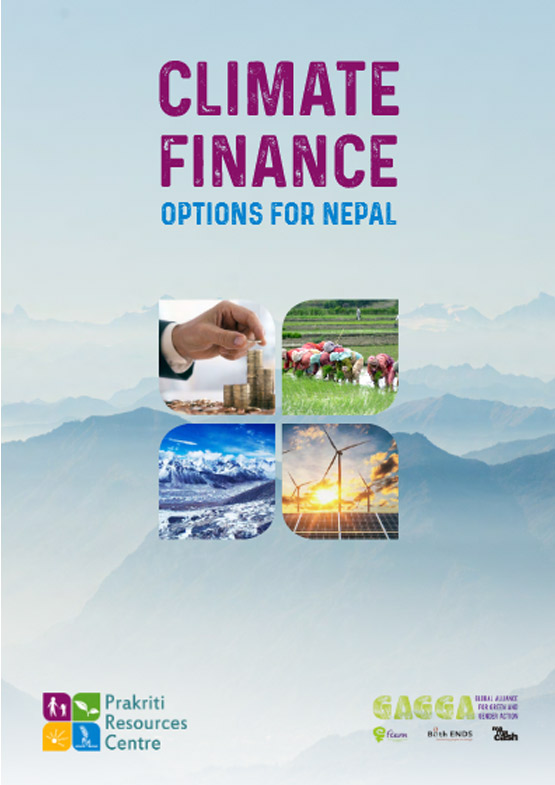
This book aims to provide information on the available funds that are relevant to Nepal for financing climate-related programs and projects. This book has only explored potential multilateral and bilateral fund sources and briefly come up with sources’ background, geographic focus, investment areas, funding conditions and modalities, application procedures, safeguards and gender, projects in Nepal, and contact points.
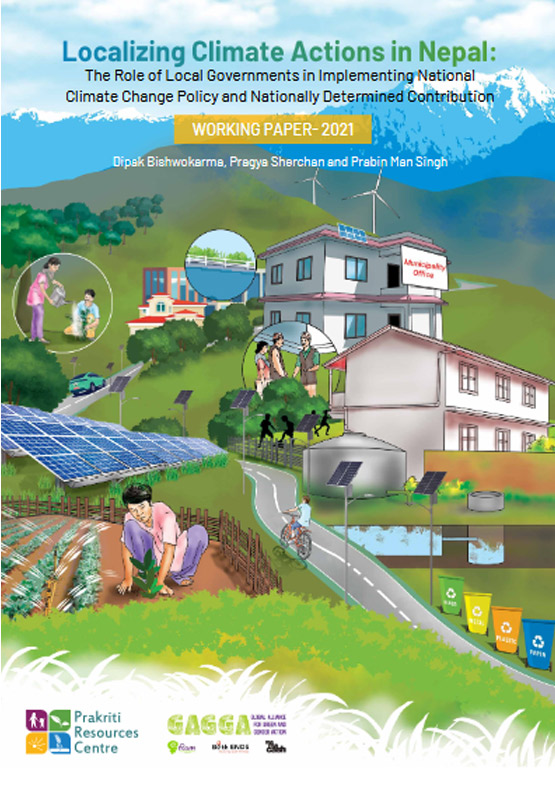
This working paper examines the role of local governments and analyses the barriers to and potential options of localizing National Climate Change Policy (NCCP) and second Nationally Determined Contributions (NDC) of Nepal. Lack of local governments’ familiarity with NCCP and second NDC, absence of qualified human resources, inadequate funding, non-existence of institutional mechanism to lead the implementation of policies and monitoring of the implementation status were the identified barriers. It has proposes a four-pillar framework for effective localization of NCCP and second NDC. It is an output of the project funded by Both ENDS and GAGGA.
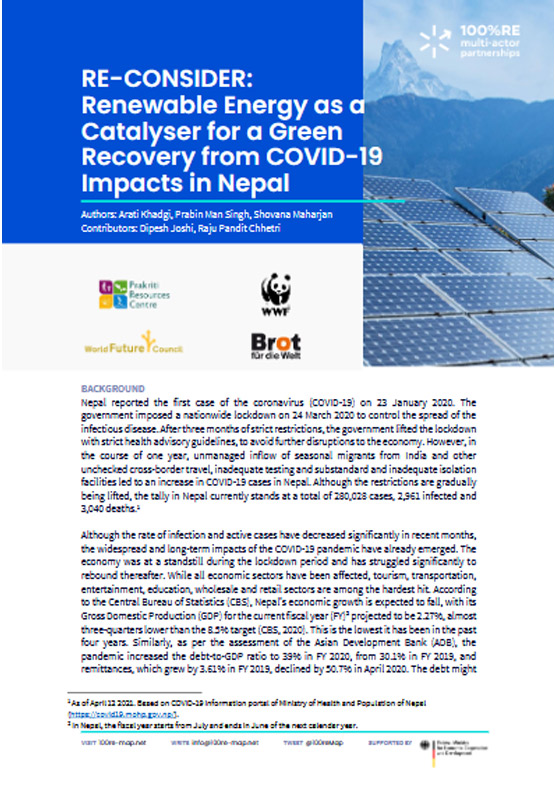
Nepal reported the first case of COVID-19 in January 2020. In March 2020 government imposed a nationwide lockdown. The economy was at a standstill during the lockdown period and has struggled significantly to rebound thereafter. While all economic sectors have been affected, tourism, transportation, entertainment, education, are among the hardest hit. This paper has discussed different aspects of COVID19 and Renewable Energy in Nepal.
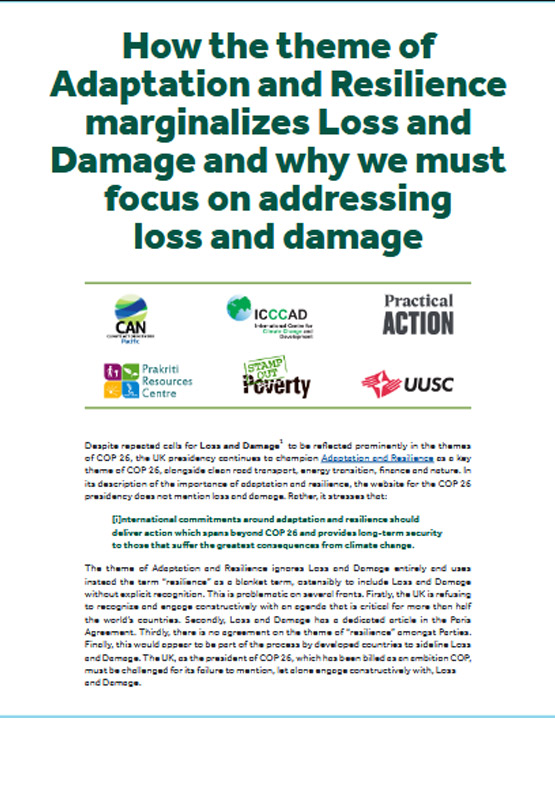
The theme of Adaptation and Resilience ignores Loss and Damage entirely and uses instead the term “resilience” as a blanket term, ostensibly to include Loss and Damage without explicit recognition. This is problematic on several fronts. This paper briefly describes why it is critical that Loss and Damage be reflected prominently, both as a theme for discussions and as a focus of action, in the lead up to, and beyond COP 26.
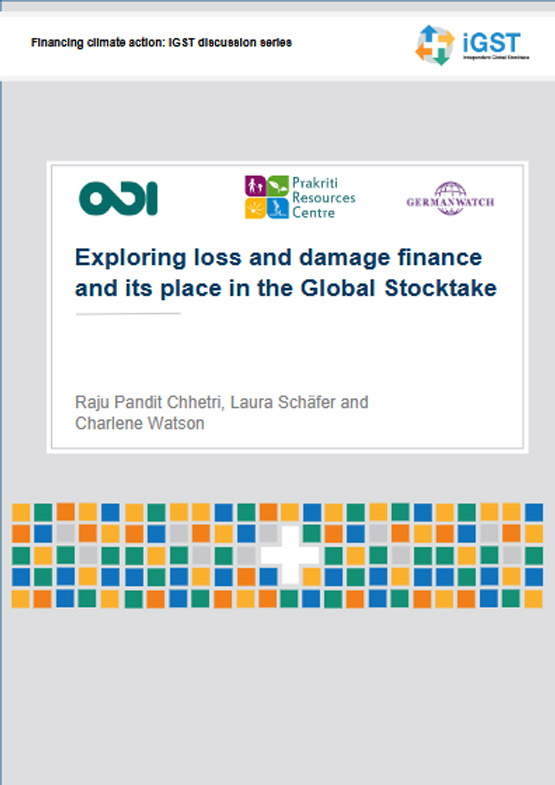
A new report from the Finance Working Group of the independent Global Stocktake (iGST), co-authored by the PRC, explores loss and damage finance and its place in the Global Stocktake. It outlines the practical challenges faced by national stakeholders and international climate finance providers in progressing the financing of loss and damage and in monitoring and tracking such finance. It also highlights the opportunity that the first GST of the Paris Agreement in 2023 presents for progressing L&D finance challenges.
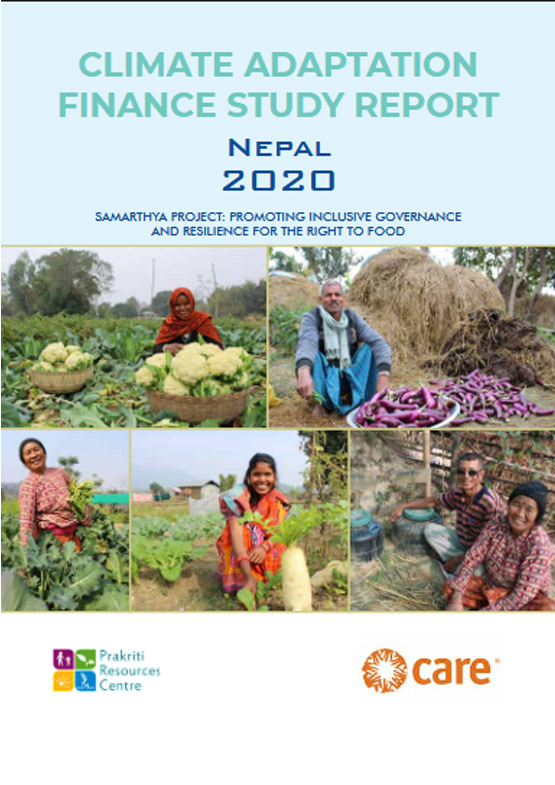
This report presents part of the outcome of an international pilot project on tracking climate adaptation finance which was simultaneously conducted covering six developing countries – Nepal, Ghana, Uganda, Ethiopia, Vietnam, and the Philippines. In Nepal, PRC has carried out this study in which analysis assessed multilateral and bilateral projects in support of climate change adaptation in the respective countries.
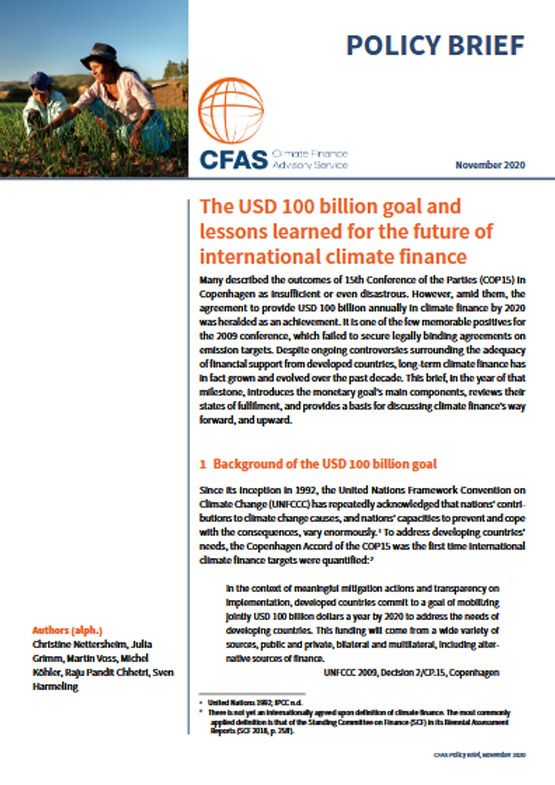
The formal negotiations on the post-2025 goal are yet to take off. But taking previous negotiations on climate finance matters into consideration, efforts of navigating all interests towards a satisfying decision should not be underestimated – not to mention the delay already imposed by the COVID-19 pandemic. In light of this, this policy brief addresses key elements that should be considered for the process leading towards the definition of a post-2025 goal. Find more
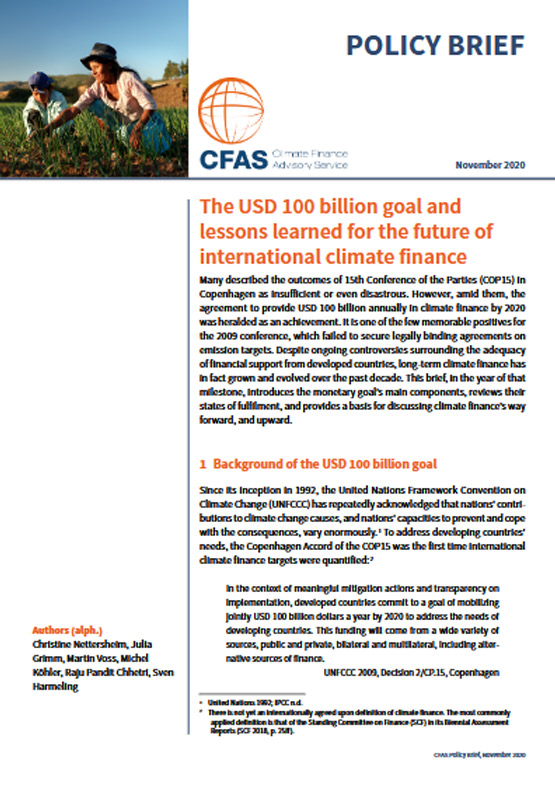
Despite ongoing controversies surrounding the adequacy of financial support from developed countries, long-term climate finance has in fact grown and evolved over the past decade. This brief, in the year of that milestone, introduces the monetary goal’s main components, reviews their states of fulfillment, and provides a basis for discussing climate finance’s way forward, and upward.Find more
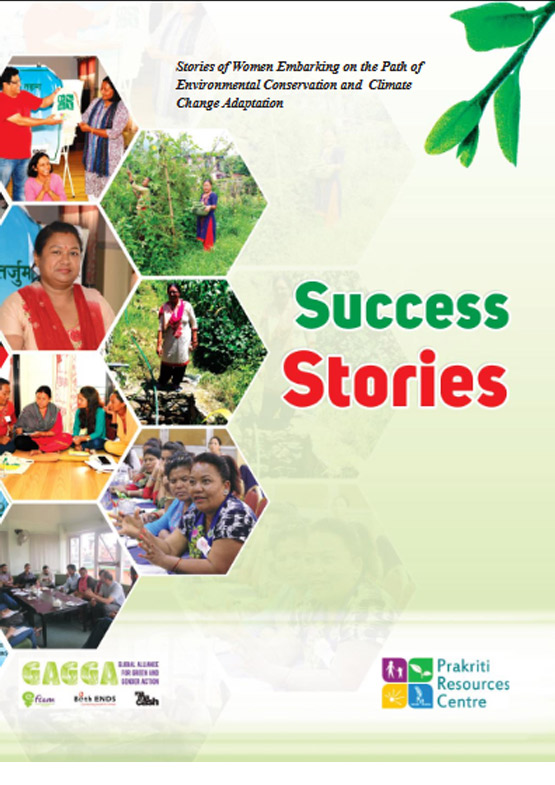
The success stories are an outcome of the project ‘Increasing Women’s Influence in Local Governance for Gender and Climate Smart Plans and Programmes’ implemented by PRC with grant assistance of Both Ends and Global Alliance for Green and Gender Action (GAGGA). We would like to put on record our gratitude to women’s groups, whose commitment and effort led to the successes inspiring us to collect these stories.
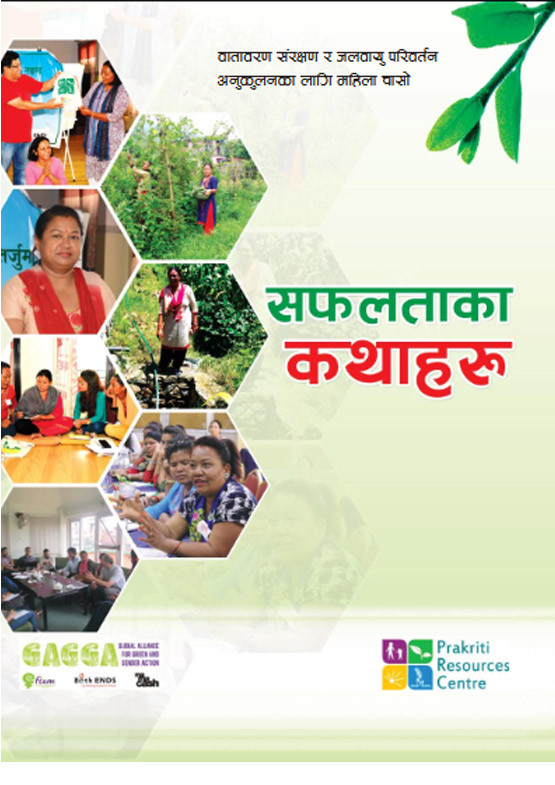
The success stories are an outcome of the project ‘Increasing Women’s Influence in Local Governance for Gender and Climate-Smart Plans and Programmes’ implemented by PRC with grant assistance of Both Ends and Global Alliance for Green and Gender Action (GAGGA). We would like to put on record our gratitude to women’s groups, whose commitment and effort led to the successes inspiring us to collect these stories.
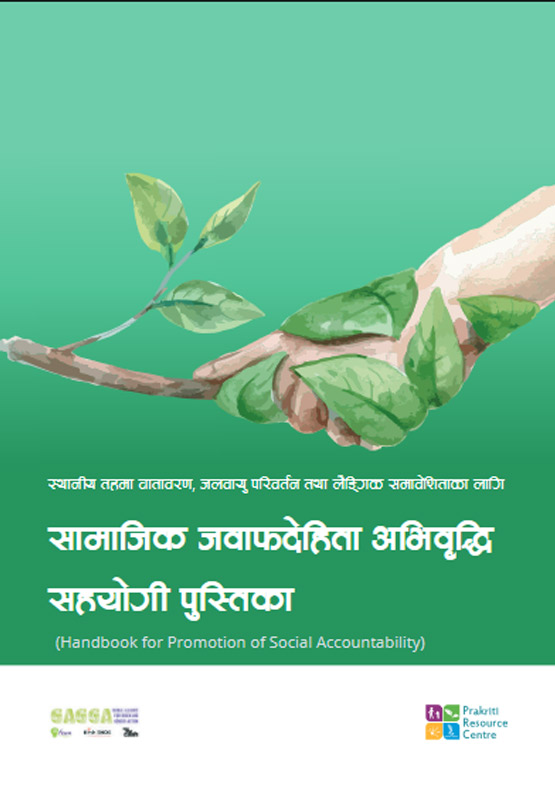
The book is expected to help increase women’s knowledge of social responsibility and ensure accountability in their social activities and in the planning and budgeting of municipalities. The book was published under the project Increasing Women’s Influence in Local Governance for Gender and Climate Smart Plans and Programme implemented with the financial support of GAGGA and Both Ends.
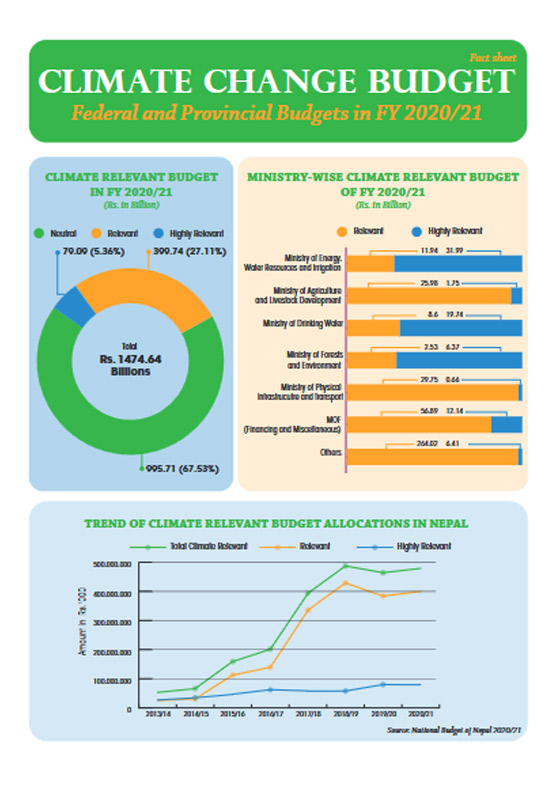
This fact sheet provides a graphical presentation of the climate-relevant budget of federal and provincial governments of Nepal in FY 2020/21. This also shows a trend of climate change relevant budget by the federal government of Nepal since FY 2013/14. This is a part of PRC’s ongoing advocacy to make climate finance transparent and accountable.
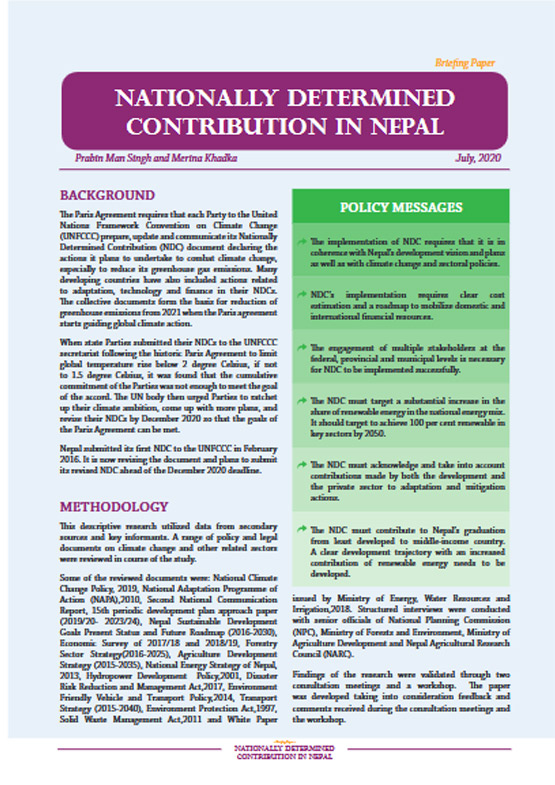
This briefing paper is a concise version of a research report prepared as a part of a research project entitled ‘Policy Gaps and Needs Analysis for the Implementation of NDCs on Adaptation and Loss and Damage in Bangladesh, Nepal and Sri Lanka.’ It identified and assessed gaps and needs of the existing policies on NDCs implementation Nepal, Bangladesh and Sri Lanka.
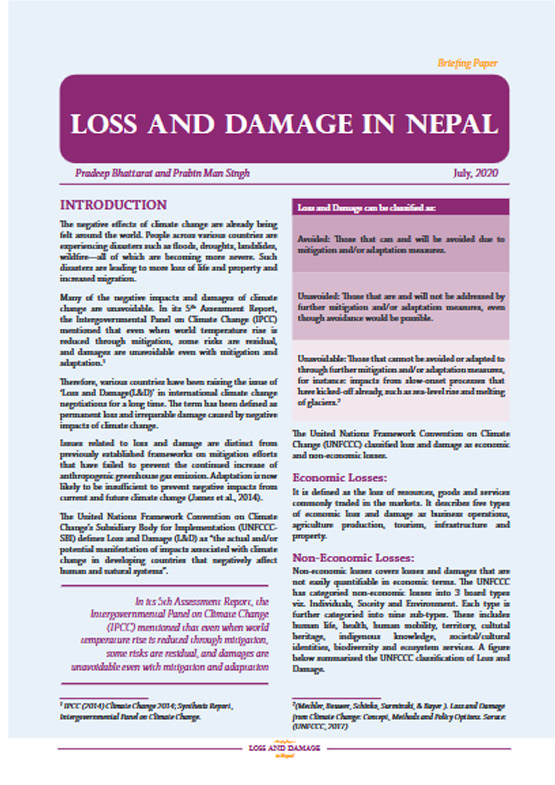
This publication is published by Prakriti Resources Centre. The document covers the brief introduction on Loss and Damage, Loss and Damage in UNFCCC, Loss and Damage in Paris Agreement, Climate Finance in terms of Loss & Damage, Loss and Damage in Nepal, and National Policy and Institutional context to address Loss & Damage in Nepal.
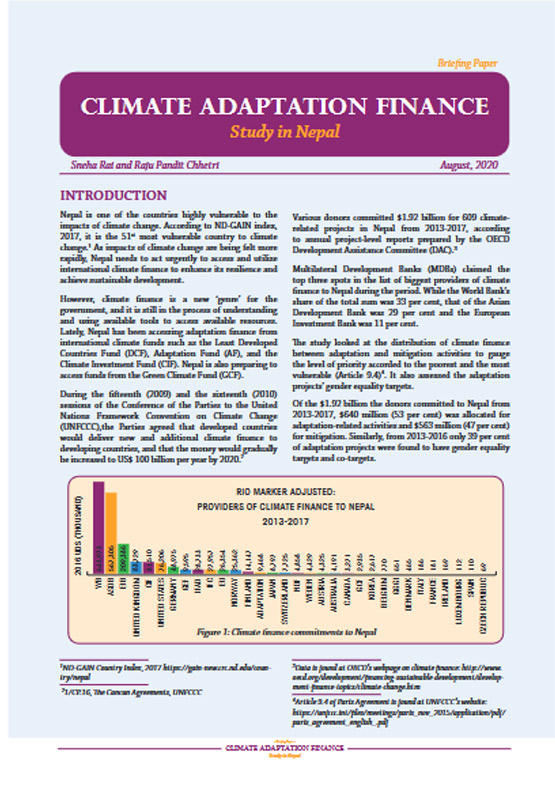
This briefing paper is a concise version of a research report prepared as part of an international pilot project on adaptation finance tracking. The project entitled ‘Climate Adaptation Finance Study in Nepal’ looked into the accuracy of multilateral and bilateral donors’ reporting on adaptation finance and the focus of their adaptation activities on the poorest and the most climate-vulnerable sections of the country’ population. The study was conducted with financial support from CARE.
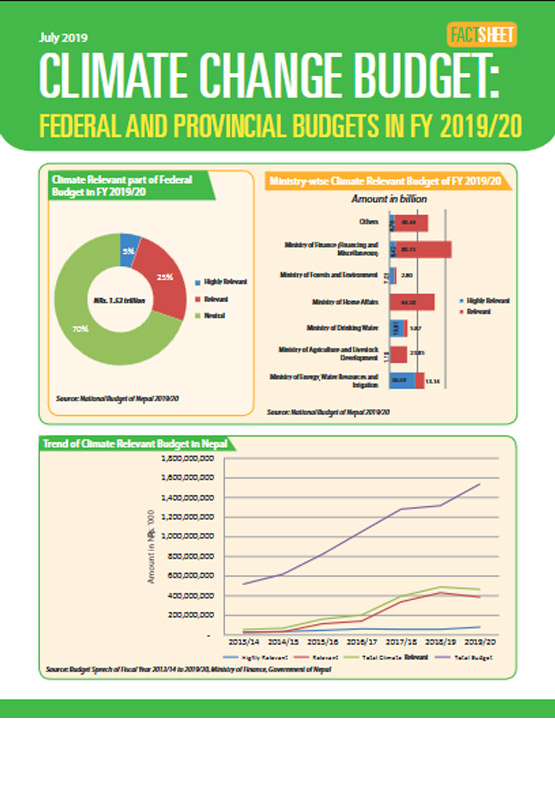
This fact sheet provides a graphical presentation of the climate relevant budget of federal and provincial governments of Nepal in FY 2019/20. This also shows a trend of climate change relevant budget by federal government of Nepal since FY 2013/14. The government had initiated climate change budget coding from the same year. This is a part of PRC’s ongoing advocacy to make climate finance transparent and accountable.
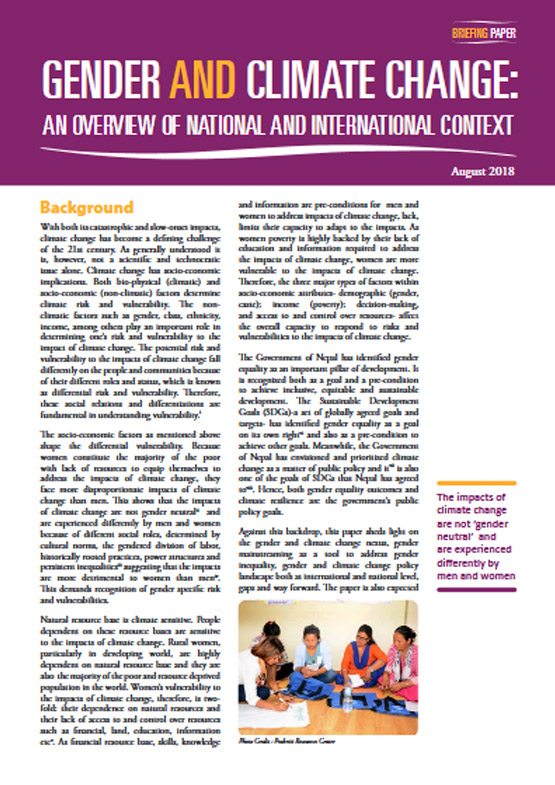
This paper sheds light on the gender and climate change nexus, gender mainstreaming as a tool to address gender inequality, gender and climate change policy landscape both at international and national level, gaps and way forward.
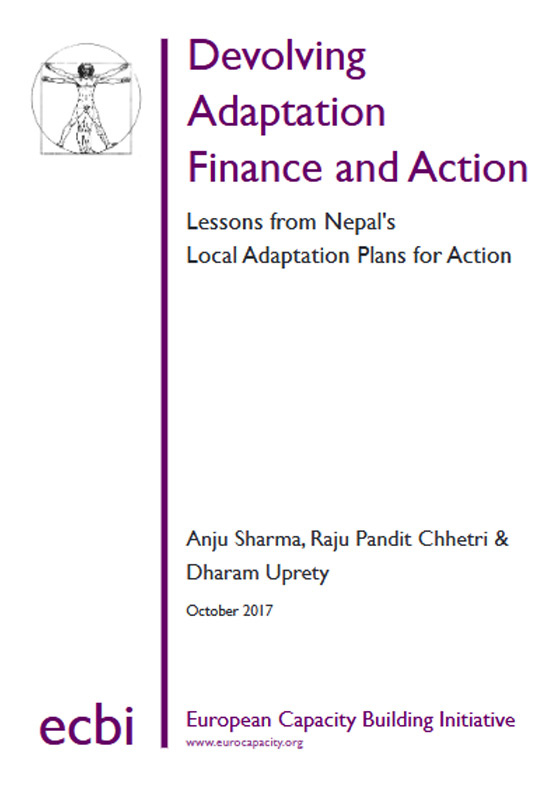
This paper aims to draw lessons for the GCF – and the EDA modality in particular – from Nepal’s experience in devolving climate finance and action. We hope that these lessons will also inform the efforts of other developing countries in making climate finance accessible at the local level, and developing EDA proposals.
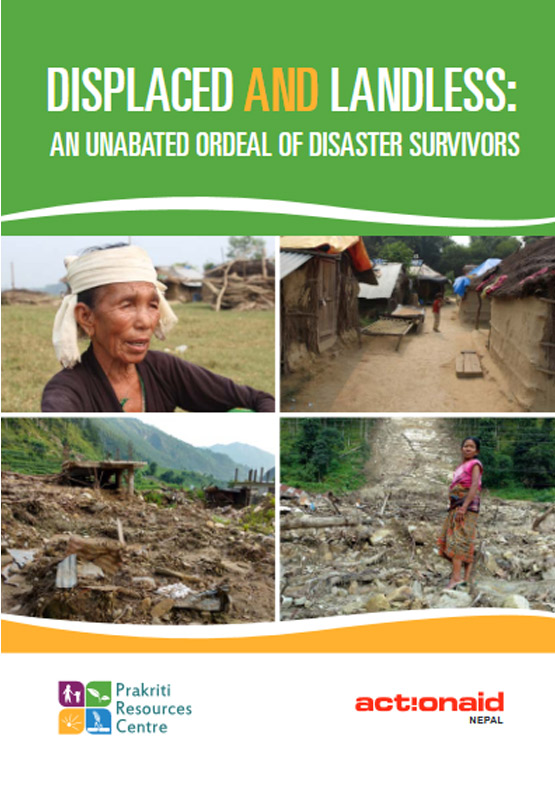
The report title “DISPLACED AND LANDLESS: AN UNABATED ORDEAL OF DISASTER SURVIVORS” focuses on the situation of the people displaced by two major disasters – flash floods in 2014 and the 2015-earthquake. Displaced families continue to live in indecent and undignified living conditions even several years after of the disasters. Hence, this report is an attempt to bring to light the situation of the people displaced by two major disasters in the country. The study also provides anecdotal evidences as to how disasters are impacting on land and causing ‘landlessness’ forcing affected people to migrate.
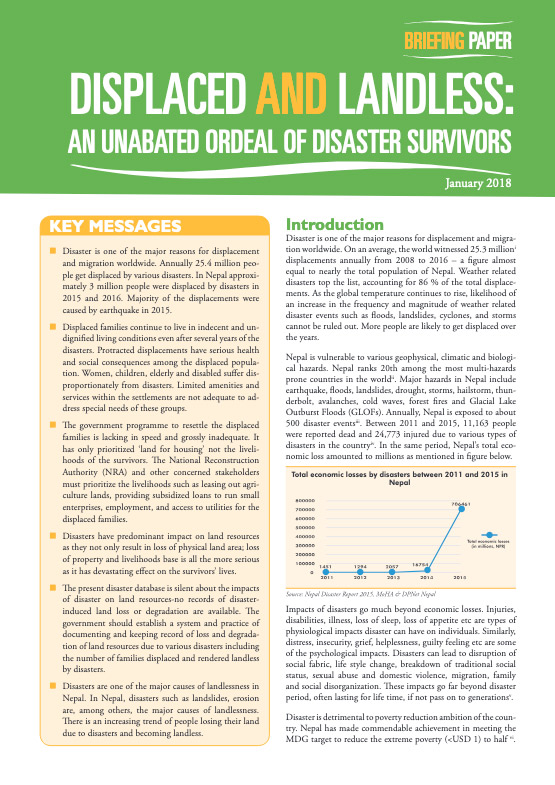
The Briefing paper summarizes the research report title“DISPLACED AND LANDLESS: AN UNABATED ORDEAL OF DISASTER SURVIVORS” focuses on the situation of the people displaced by two major disasters – flash floods in 2014 and the 2015-earthquake. Its major highlight is on the government resettlement programme which is slow and grossly inadequate which has prioritized ‘land for housing’ and not for livelihood of survivors.
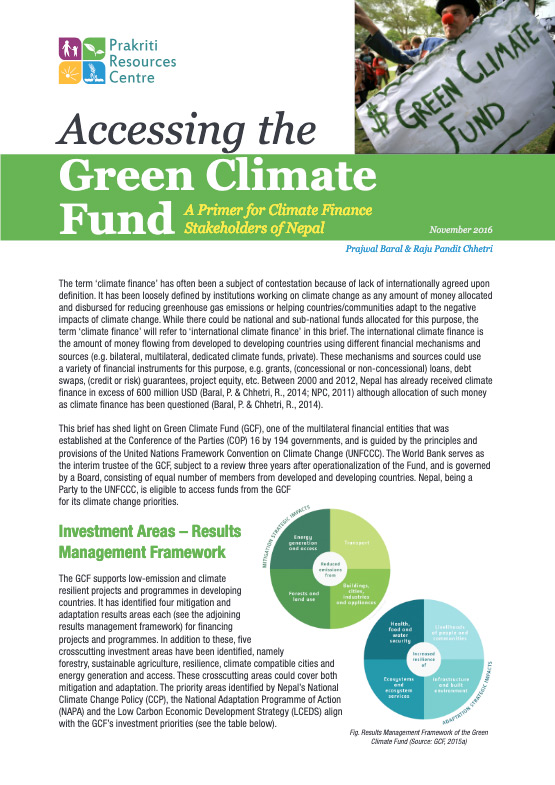
This brief has shed light on Green Climate Fund (GCF), one of the multilateral financial entities that was established at the Conference of the Parties (COP) 16 by 194 governments, and is guided by the principles and provisions of the United Nations Framework Convention on Climate Change (UNFCCC).